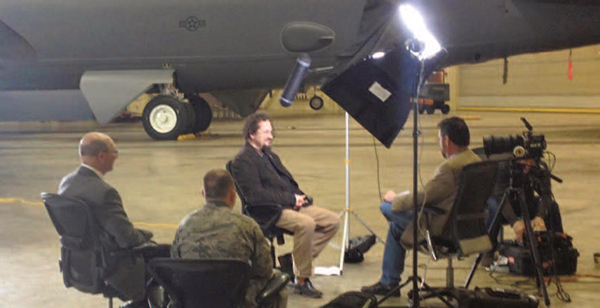Exploring the evolution of nuclear deterrence through interviews, historical footage
Sandia is exploring the evolution of nuclear deterrence in a documentary that combines modern and historical footage with a wide range of interviews.
On Deterrence features interviews with former secretaries of defense, general officers, policymakers, analysts, scholars, and scientists with varied viewpoints to describe the impact of nuclear deterrence since the end of World War II. The film presents a broad look at nuclear deterrence and explores how the concept might evolve in response to changes in the global strategic balance and the twin threats of proliferation and terrorism.
Sandia President and Laboratories Director Jill Hruby says deterrence is a cornerstone of defense for the US and its allies and remains important 25 years after the end of the Cold War.
“Sandia has a role to play in the national debate on deterrence, and this documentary can contribute to that discussion,” she says.
Sandia filmmaker Dan Curry, now retired, began work on the film in 2011. The documentary, which runs an hour and 42 minutes, builds on his earlier Sandia documentaries, Always/Never: the Quest for Safety, Control & Survivability, released in 2015, and US Strategic Nuclear Policy.
Curry spent about six months studying the evolution of nuclear deterrence. “It has such breadth and depth that I struggled to narrow the topic,” he says. The goal “was not to tell the story of, but to follow the evolution of deterrence.”

History as a springboard
Curry used history as a springboard to discuss important concepts like credibility, which underpins deterrent threats. He says he relied on those interviewed to narrate the history and to describe and define how nuclear deterrence operates today.
The intent of this film is to make a lasting contribution to the history of deterrence . . . not to advocate any one viewpoint.
Steve Rottler, deputy Labs director and executive VP for National Security Programs, says Sandia is pleased to be a part of deterrence history and further national conversation because of its unique responsibilities in nuclear weapon design, production, and maintenance.
The intent of this film is to make a lasting contribution to the history of deterrence . . . not to advocate any one viewpoint.
“The intent of this film is to make a lasting contribution to the history of deterrence and to the long-term dialogue about the role of US nuclear weapons as a deterrent, not to advocate any one viewpoint,” he says. “We’re very proud of Dan’s efforts to present a balanced, intellectual, and deeply insightful perspective on the complex topic of deterrence. We’re grateful to him and to all of the experts who gave their time for this.”
Jerry McDowell, who preceded Steve as deputy Labs director before retiring in 2015, asked after seeing Always/Never whether he could commission Curry to do a documentary on the relevance of nuclear weapons in the current era.
“I realized that Sandia had hired so many new people, some of whom had not come of age until after the Cold War,” he says. “There’s a generation of people for whom this topic feels like a legacy; I wondered if they would benefit from added context in which to understand the history of nuclear deterrence and its impact on global security today.”
Among those interviewed for On Deterrence are NNSA head Gen. Frank Klotz; Stephen Younger, a senior policy scholar at the Woodrow Wilson Center at the time and now designated as Sandia’s next Labs director; former Los Alamos National Laboratory director Sig Hecker; former US Sens. Sam Nunn of Georgia and Jon Kyl of Arizona; Stanford University senior fellow Scott Sagan, author of The Limits of Safety: Organizations, Accidents, and Nuclear Weapons; former secretaries of Defense James Schlesinger, Robert Gates, and William Perry; Ploughshares Fund president Joseph Cirincione; Carnegie Endowment for International Peace senior associates Ashley Tellis and James Acton; and Rose Gottemoeller, former undersecretary for arms control and international security at the State Department.
On Deterrence can be viewed below or on Sandia’s YouTube channel at https://youtu.be/tQBLpJFi6f0.